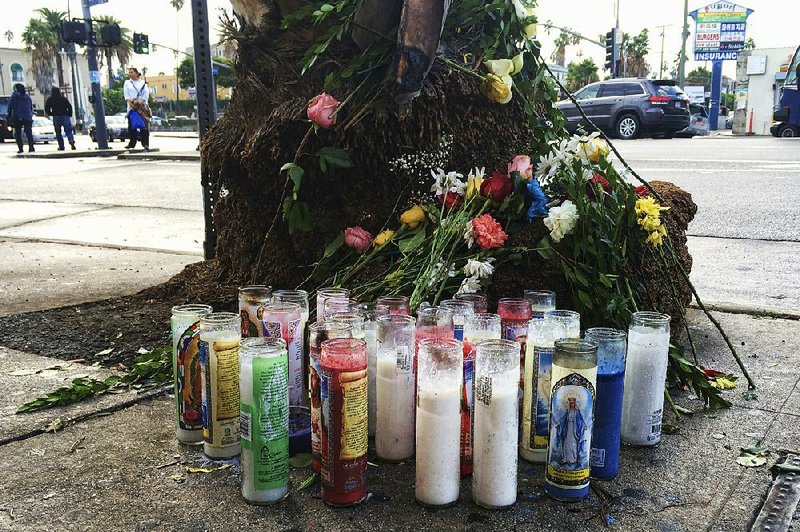PALM SPRINGS, Calif. -- A maintenance crew had slowed traffic on a California highway through the night, and the work had gone on for hours without problems.
Then a tour bus returning to Los Angeles from a casino trip slammed into the back of a semi-truck.
Passengers who were asleep on the bus woke to the sounds of crushing metal and screams.
The gambling jaunt ended in one of the deadliest wrecks in California history with 13 people killed and 31 others injured.
Authorities said the truck was traveling at 5 mph when the bus, moving as fast as 65 mph, plowed into it on Interstate 10 just north of the desert resort town of Palm Springs.
The crash crushed the front 15 feet of the bus.
It was not known whether alcohol, drugs or fatigue played a role in the crash, but the bus was inspected in April and had no mechanical issues, California Highway Patrol Border Division Chief Jim Abele said. The bus driver was killed, and the truck driver received minor injuries.
The National Transportation Safety Board was investigating.
The bus was coming from Red Earth Casino in the desert town of Thermal and was about 35 miles into its 135-mile trip back to Los Angeles. California Highway Patrol officers had been slowing traffic to allow utility workers to string wires across the freeway, Abele said.
Passengers said most people were asleep when the crash occurred shortly after 5 a.m. Abele said it appeared the 1996 bus didn't have seat belts and likely didn't have a data recorder outfitted in newer vehicles.
Ana Car, 61, said she never felt the crash but awoke to the horror of screaming and crying. Most passengers had been flung to the front of the bus and those who could move were pushing and shoving in the dark to climb out from under each other.
The retired factory worker started screaming and clambered to a broken window to yell for help, panicked that she would be trapped if the bus caught fire.
Motorists who stopped to help pulled her out the broken window.
"I couldn't stand when they got me out," Car said. "I sat on the side of the road, watching them pull so many people out. I saw so much blood and two dead bodies. I was so scared."
Before April, the bus was inspected in 2014 and 2015, the California Highway Patrol said. Federal Motor Carrier Safety Administration records show it had no crashes in the past two years and had a satisfactory safety rating.
The front of the bus crumpled into the semi-truck's trailer, and debris was scattered across the key route through Southern California.
Firefighters used ladders to remove bodies through windows, and tow trucks lifted the trailer to make it easier to reach the bus, whose front end was demolished.
Fourteen people were sent to Desert Regional Medical Center in Palm Springs, the area's only trauma center.
Of the eight who were still known to be hospitalized, four remained in critical condition Monday, hospital officials said.
Many suffered facial injuries, a telltale sign they were not wearing seat belts, said Ricard Townsend, a trauma surgeon.
"It seemed as though most of the victims were unrestrained and were therefore [thrown] through the air and ended up sustaining facial trauma," he said.
The Riverside County sheriff-coroner's office identified 11 of the 13 people killed, naming nine women between the ages of 52 and 72, a 62-year-old man, and the bus owner-driver, Teodulo Vides, 59.
All were from Los Angeles except for a woman who was from Palmdale. A man and woman had not been identified.
The safety board planned to look into the history of the bus, its owner-driver and other circumstances, such as what the driver was doing during the four to five hours the bus was at the Red Earth Casino in Thermal.
Teodulo Elias Vides, 59, was listed as owner of the bus company, USA Holiday, according to federal and state records.
He had a valid commercial license and a clean record in recent years.
USA Holiday was licensed to travel between states, which subjected Vides to federal limits on driver work hours.
Under the scenario officials described -- leaving Los Angeles at 8 p.m. and returning less than 12 hours later -- Vides would have been within those limits, which cap driving time to 10 hours within a 15-hour span and do not prescribe specific rest requirements.
A call to the company was not returned.
Vides was named in lawsuits stemming from three freeway collisions, though he was not the driver in any of the cases, according to court records.
In 2007, a USA Holiday bus collided with a Honda Civic in Riverside, killing the car's driver and two passengers.
Family members filed a personal injury and negligence lawsuit against the driver of the bus and Vides, whose attorneys argued that the Honda driver lost control. That case was dismissed.
USA Holiday says on social media that it has more than 25 years of experience traveling to casinos in Southern California.
It posts about quick turnaround trips leaving the Los Angeles area to casinos in the Southern California desert area and Las Vegas.
The crash occurred two years after a FedEx truck veered across an interstate median north of Sacramento and slammed into a bus full of high school students, killing 10 people.
Information for this article was contributed by Julie Watson, Courtney Bonnell, Daisy Nguyen and John Antczak of The Associated Press.
A Section on 10/25/2016
